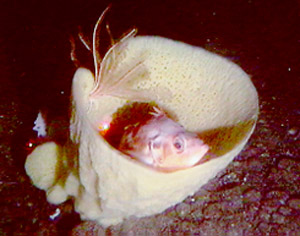The Magnuson -Stevens Act mandates that any Fisheries Management Plan (FMP) must include a provision to describe and identify essential fish habitat (EFH) for the fishery, minimize to the extent practicable adverse effects on such habitat caused by fishing, and identify other actions to encourage the conservation and enhancement of such habitat. Essential fish habitat has been broadly defined by the Act to include "those waters and substrate necessary to fish for spawning, breeding, feeding, or growth to maturity ".
In March 2006, NOAA Fisheries published a proposed rule that would close large areas of the Alaskan sea floor to bottom-contact fishing gear to protect sensitive habitats. The proposed rule would implement a February 2005 recommendation from the North Pacific Fishery Management Council, establishing a network of fishing closures in the Aleutian Islands and Gulf of Alaska. The habitat areas to be protected include cold water corals and other sensitive features that are slow to recover once disturbed by fishing gear or other activities.
This proposal would close most of the Aleutian Islands fishery management area to bottom trawling, creating the largest marine protected area in the United States: about the same size as the entire states of Texas and Colorado combined. Fishing areas that have been trawled repeatedly in the past would remain open. A zone on Bowers Ridge north of Adak would be closed to mobile bottom-contact gear such as trawls, but fixed gear including crab pots would still be allowed. Six small areas that include especially sensitive "coral gardens" would be closed to all bottom-contact fishing gear, including trawls, pots, and dredges. These vulnerable coral gardens were discovered by NOAA Fisheries scientists in 2002 and have been observed nowhere else.

Benthic invertebrates such as this sponge provide habitat for a variety of fish species.
In the Gulf of Alaska, ten areas along the continental slope would be closed to bottom trawling to protect hard bottom that may be important to rockfish. Five small areas in southeast Alaska, in the Fairweather Grounds and off Cape Ommaney, would be closed to all bottom-contact fishing to protect dense thickets of red tree corals. Another fifteen areas offshore would be closed to all bottom fishing to protect seamounts. In total, the proposed regulations would affect nearly 300,000 square nautical miles off Alaska. However, NOAA Fisheries predicts that the closures will have only small economic effects on the fishing industry because fishermen do not rely heavily on the areas that would be closed.
 RACE scientists use a Towed Automatically Compensating Observation System (TACOS) to make demersal habitat obervations around Seguam Pass.
RACE scientists use a Towed Automatically Compensating Observation System (TACOS) to make demersal habitat obervations around Seguam Pass.
Maps of the new management areas, the Environmental Impact Statement for Essential Fish Habitat, and the analysis for Habitat Areas of Particular Concern are available online at http://www.fakr.noaa.gov/habitat/efh.htm. The website also includes instructions for commenting on the proposed regulations.

